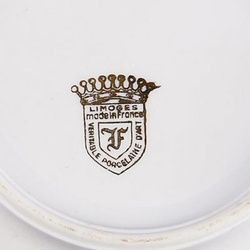
После обнаружения вещества, по составу близкого к каолину, в Саксонии в 1705 году, в 1767 году было открыто месторождение каолина в бедствующей деревеньке Сент-Ирьей-ла-Перш, неподалёку от Лиможа (на границе с Дордонью). По легенде, хирург Жан-Батист Дарне сообщил местному аптекарю о том, что его жена использует при стирке белья грунт белого цвета в качестве стирального порошка. Именно благодаря данному месторождению Лимож был призван стать столицей фарфора во Франции.
Рядом с месторождением каолина были обнаружены залежи так называемого китайского камня, по сути, каолинизированной разновидности полевого шпата.
В 1769 году 59-летний король Франции Людовик XV выкупил месторождение каолина, сделав производство фарфора королевской привилегией. Именно с этого года во Франции введено право производства фарфора и соответствующие пошлины. Первая фарфоровая мануфактура в Лимузене была основана в 1771 году братьями Грелле и Масье-Фурнера (фр. frères Grellet et Massié-Fournérat). После смерти Людовика XV в 1774 году мануфактура переходит под патронаж короля Карла X[5]. Эта мануфактура существовала в таком статусе вплоть до 1784, когда ей был присвоен статус Королевской мануфактуры. В 1794 году её присоединили к Севрской мануфактуре.
Производство фарфора во Франции существенно пострадало в годы французской революции.
Впоследствии возрождение фарфорового дела произошло благодаря французскому промышленнику Франсуа Аллюо старшему (фр. François Alluaud), ставшему первопроходцем промышленного производства лимузенского фарфора в первой половине XIX столетия. Возглавив в 1800 году фабрику, он занимался совершенствованием технологии производства и внедрением инноваций. Помимо этого, фабрика Аллюо полностью контролировала добычу каолина, месторождения которого целиком находились на её землях[6]. Так, уже в 1807 году, в Лиможе насчитывалось 5 мануфактур, на которых эксплуатировалось 7 печей и трудилось около 200 рабочих, производивших фарфоровые изделия на сумму 230 000 франков[5].
В 1827 году в Лиможе насчитывалось уже шестнадцать фабрик по производству фарфора. Период Реставрации (1814—1830 годы) характеризуется открытием большого числа фабрик в коммунах лимузенской равнины (Куссак-Бонваль, Маньяк-Бур, Солиньяк, Сен-Брис-сюр-Вьенн, Сен-Леонар-де-Нобла, Бурганёф и другие)[5]
В эту эпоху отрасль производства фарфора обеспечивала доходами большую часть населения Лимузена. Множество человек были заняты в сплаве леса, предназначенного для печей обжига на фарфоровых фабриках, его вырубке, хранении и последующей доставке на фабрики. В технологическом цикле изготовления фарфоровых изделий было задействовано множество разнообразных профессий.
Начиная с 1836 года, когда была отменена пошлина на ввоз леса в города, в том числе в Лимож, фабрики, до этого строившиеся в пригородах, стали массово переводиться в города. Только в 1830-х годах в Лиможе было открыто 8 новых фарфоровых заводов. А к середине XIX века, благодаря деятельности американца Хевиленда, фабрик было уже свыше 30.
Именно Хевиленду удалось пленить Париж качеством и изысканностью лимузенской фарфоровой продукции. Также он существенно развил направление декорирования фарфоровых изделий прямо на месте, в Лимузене, в соответствии со вкусами американской клиентуры. Именно в 1853 году состоялось открытие первой фабрики, совмещавшей цеха по изготовлению фарфора и мастерскую по декорации фарфоровых изделий, где в совокупности трудилось 400 работников В 1848 году в Лиможе насчитывалось 19 производящих фабрик и 17 мастерских по росписи фарфора. Общий оборот отрасли достиг 4 миллионов франков.
Производство фарфора - с 1771 г.
В 1771 г братья Грелле вместе с Массье - хозяином фаянсовой фабрики, существовавшей в Лиможе, и химиком Фурнье основали фабрику твердого фарфора под патронажем герцога Артуа. В 1784 г. фабрика перешла в собственность короля. На ней производили только белый фарфор, который потом расписывали в Севре. Фабрика закрылась в 1796 г. На протяжении XIX-XX вв. в Лиможе существовало сорок три фабрики фарфора. Центр керамического производства в Лиможе относится к самым большим во Франции, и продукцию, создаваемую там, ценят за высокое качество.








